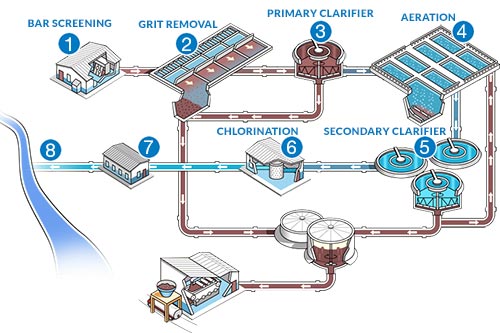Exploring Cutting-Edge Developments in Wastewater Technology
Exploring Cutting-Edge Developments in Wastewater Technology
Blog Article
Recognizing Wastewater Treatment Processes and Their Environmental Influence
The complexities of wastewater therapy procedures play a critical function in mitigating ecological difficulties connected with water air pollution. Each phase, from preliminary to advanced therapies, is created to attend to details pollutants, eventually protecting both public health and wellness and aquatic environments.
Overview of Wastewater Therapy
Exactly how is wastewater changed right into a risk-free source for the environment? Wastewater therapy is an essential process developed to get rid of pollutants from made use of water, thus protecting public health and wellness and safeguarding environments. This procedure begins with the collection of wastewater from property, industrial, and industrial sources, which is then guided to treatment centers.
At these centers, various physical, chemical, and organic techniques are employed to deal with the wastewater. Ultimately, biological therapies, such as turned on sludge procedures, make use of bacteria to damage down organic issue.
The dealt with effluent can be safely released into natural water bodies or recycled for watering and industrial functions, promoting resource conservation. Furthermore, the treatment process creates biosolids, which can be repurposed as plant foods or soil amendments, further improving sustainability.
Phases of Therapy Processes
The wastewater therapy process normally contains 3 key stages: initial, main, and second treatment. Each phase serves an unique role in decreasing the toxin lots and making certain the effluent meets environmental criteria before discharge.
The key treatment stage focuses on the physical splitting up of put on hold solids from the wastewater. Through sedimentation, larger bits resolve at the end of sedimentation storage tanks, creating sludge, while lighter materials, such as oils and greases, float to the surface and are skimmed off. This process significantly lowers the organic and not natural load in the wastewater.
Second treatment is an organic procedure intended at additional reducing the concentration of organic issue. This stage is vital for achieving the necessary biochemical oxygen need (BOD) decrease, ultimately leading to cleaner effluent ready for discharge or additional therapy.

Advanced Treatment Technologies
Following the additional treatment procedures, advanced treatment technologies play a vital duty in additional boosting the top quality of dealt with wastewater. These technologies are made to eliminate residual contaminants that are not successfully removed during primary and second treatments, guaranteeing the effluent satisfies rigid regulative criteria.
Among the commonly made use of innovative therapy methods are membrane filtering, reverse osmosis, and progressed oxidation procedures. Membrane purification, consisting of microfiltration and ultrafiltration, works in separating great particles, pathogens, and colloids from the water (Wastewater). Reverse osmosis uses semi-permeable membrane layers to get rid of liquified solids, leading to high-grade water appropriate for various applications
Advanced oxidation processes (AOPs) use solid oxidants to weaken natural contaminants, including basics drugs and personal treatment items that are immune to conventional treatment. These approaches enhance the biodegradability of complex compounds, facilitating their removal.
Another significant innovation is using biological nutrient removal processes, which especially target nitrogen and phosphorus, stopping eutrophication in getting water bodies. On the whole, innovative therapy technologies are important for achieving higher levels of filtration, promoting water reuse, and securing public health and wellness while resolving the obstacles connected with wastewater administration.
Environmental Benefits of Therapy
Countless ecological advantages develop from reliable wastewater therapy processes that add to ecosystem health and sustainability. Primarily, these procedures substantially minimize the release of dangerous toxins into all-natural water bodies, which assists maintain water ecological communities. By getting rid of pollutants such as heavy steels, nutrients, and virus, dealt with wastewater alleviates the danger of waterborne diseases and advertises biodiversity in marine environments.
Moreover, wastewater therapy centers typically employ innovative innovations that allow water recycling and reuse. This practice not just saves fresh water resources yet likewise decreases the need on all-natural water supplies. Boosted nutrient elimination from wastewater can also protect against eutrophication, a procedure that leads to algal blossoms and succeeding oxygen deficiency in aquatic systems.
Additionally, reliable treatment procedures can lessen greenhouse gas discharges, particularly methane and laughing gas, which are typically launched during untreated wastewater disintegration. By capturing and using biogas from anaerobic digesters, facilities can transform waste into renewable resource, therefore contributing to a decrease in fossil fuel reliance.
Obstacles and Future Trends
While the ecological benefits of wastewater therapy are clear, several difficulties linger that hinder ideal outcomes in this field. One significant concern is maturing other facilities, which check my reference often leads to ineffectiveness and increased operational prices - Wastewater. Many therapy plants were made decades back, and their capacities do not align with contemporary demands, that include more stringent governing standards and higher volumes of wastewater as a result of urbanization

Looking in advance, there is an expanding emphasis on resource recuperation and round economic climate principles within wastewater treatment. Innovations such as anaerobic digestion, which can produce biogas, and advanced purification innovations are acquiring traction. These approaches not only enhance therapy effectiveness but also promote sustainability.
Ultimately, attending to these obstacles needs partnership among stakeholders, financial investment in technology, and a commitment to recurring study. By welcoming these fads, the wastewater therapy sector can advance to meet the needs of a transforming environment and society.
Final Thought
In final thought, wastewater therapy procedures play a vital role in improving ecological top quality and public wellness. The multi-stage therapy framework, paired with innovative technologies, efficiently reduces contamination and advertises lasting water monitoring.
Report this page